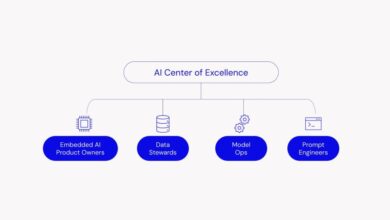Why you need an AI Strategy: 4 barriers preventing you from capturing value

Managing Director of Data & AI
The biggest obstacle to scaling AI often isn’t the lack of technical skills but of a strategic direction. When companies don’t follow a clear direction for new AI projects, they fall into one of two traps:
Scattered pilots that don’t connect to core business goals lead to duplicated efforts, inconsistent tools, rising costs, and long-term technical debt. Despite that, many companies assume that defining an AI strategy upfront is expensive or slows things down.
But in reality, the absence of strategy is what creates chaos:
A clear AI strategy provides decision-makers with:
Many executives feel pressure to act on AI but aren’t confident in what questions to ask or how to steer the initiatives. They struggle to separate hype from value and often expect instant results without understanding the trade-offs.
Lack of AI fluency across the executive team also often creates a mismatch between expectations and execution. A well-defined strategy helps close this gap by making roles clear, surfacing the right questions, and connecting technical work to tangible business outcomes
When evaluating the ROI of AI initiatives, companies often fail to account for:
AI strategy can reframe the ROI conversation from “what do we save now” to “what capabilities are we enabling”, such as:
Most companies underestimate how much their existing data infrastructure can limit AI progress beyond initial pilots because the technical foundation isn’t built for scale.
These are the most common blockers making even simple AI applications hard to implement:
Organizations that scale AI successfully don’t wait for the perfect data. But they still build with the future in mind. Instead of treating data as a static resource, rethink how AI will change your ways of working in the long-run:
1. Build data foundations around specific use cases, not abstract data goals. Start by asking: “What outcome are we trying to achieve?” — then work backward to define the data you need.
2. Structure systems in a modular, flexible way so tools and data can connect easily. Avoid building isolated pipelines that can’t scale or be reused.
3. Give cross-functional teams hands-on access to data and the ability to improve it as they go. Don’t rely on centralized data owners or rigid governance processes.
Many AI initiatives fail not because the tech doesn’t work but because the organization around it doesn’t adapt to the new ways of working. Even with the right data and a strong use case, execution breaks down when roles are unclear, teams are misaligned, and there’s no structured way to manage AI across the business.
The most common operating model issues include:
Without alignment on who’s responsible, how decisions are made, and how initiatives are prioritized, AI stays stuck in isolated experiments. Today, AI sits at the intersection of product, data, operations, and strategy. That makes cross-functional coordination essential.
Without organizational guiderails in place, even promising pilots stall in handover, and efforts get duplicated. Always keep in mind:
So far, most AI roadblocks have shown themselves to be human, not technical. Many companies still struggle to embed AI into the way people actually work. That’s because the biggest friction often comes from mindset, habits, and incentives.
Common people and cultural barriers include:
When teams see pilot after pilot with no real impact or integration into daily work, enthusiasm fades fast. Over time, this creates a culture of skepticism where AI is seen as just another top-down initiative that won’t stick.
Overcoming pilot fatigue requires:
Companies that succeed with AI do things differently:
If you want AI to deliver real outcomes, start with strategy.



